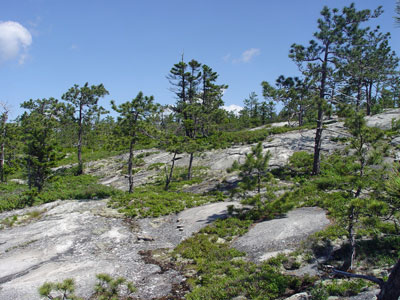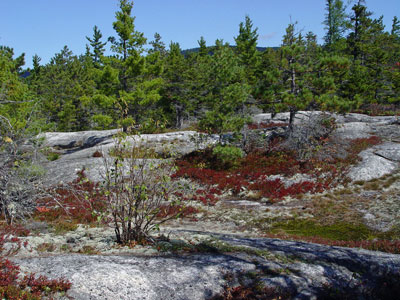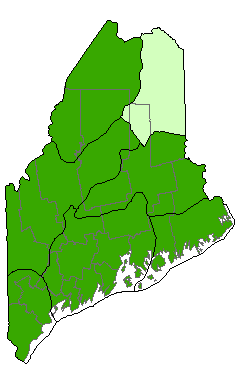DACF Home → Bureaus & Programs → Maine Natural Areas Program → Communities, Plants, and Animals → Natural Community Fact Sheets → Red Pine Woodland
Printer Friendly Fact Sheet - 1 MB pdf (Get a free copy of Adobe Acrobat Reader)
Red Pine Woodland
Scientific Name: Red Pine Woodland; State Rank: S3

- Community Description
- Soil and Site Characteristics
- Diagnostics
- Similar Types
- Conservation, Wildlife and Management Considerations
- Distribution
- Characteristic Plants
- Associated Rare Plants
- Associated Rare Animals
- Examples on Conservation Lands You Can Visit
Community Description: These open canopy woodlands (30-75% closure) are dominated by red pine. Associated canopy species vary among sites and include white pine, red spruce, or paper birch. The shrub layer includes scattered red spruce, red maple, paper birch, or gray birch. The herb layer varies in extent, but usually features heath shrubs and scattered forbs or bracken fern; graminoids are virtually absent. Bryoids are patchy and usually consist of types associated with somewhat dry conditions such as reindeer lichens. Back to top.
Soil and Site Characteristics: Sites are flat to moderately sloping and occupy low ridges or upper slopes. Most sites are inland. The substrate is usually thin soil or organic duff (<20 cm) over bedrock. Evidence of past fire is often found. Back to top.

Diagnostics: Sites are distinguished by open canopy (<65%) woodlands, usually on bedrock; with red pine dominant and oaks and northern hardwoods lacking; the herb layer is dominated by dwarf shrubs and few graminoids. Back to top.
Similar Types: Red and White Pine Forests have more complete canopy (>75%), usually lack a well developed dwarf shrub layer, and occur on deeper sandy soils. Oak - Pine Woodlands may have red pine as a component species but will have red oak or northern hardwoods as dominant trees and usually possess a more extensive graminoid cover. Back to top.
Conservation, Wildlife and Management Considerations: These occur as small patches, usually on upper slopes or hilltops. Maintaining representative examples is best accomplished by retaining adjacent forest cover as buffer. Most sites have fire evidence, and fire may be required for regeneration or persistence of this type.
Common nighthawks and whip-poor-wills may nest in open patches within red pine woodlands. This community type may include rare moths that utilize hard pines as larval host plants such as the oblique zale, southern pine sphinx, and pine pinion. Back to top.
Distribution: New England - Adirondack Province and Laurentian Mixed Forest Province, extending westward, northward, and presumably eastward from Maine. Landscape Pattern: Small Patch. Back to top.


Characteristic Plants: These plants are frequently found in this community type. Those with an asterisk are often diagnostic of this community.
- Canopy
- Paper birch
- Red maple
- Red pine*
- Red spruce
- White pine
- Sapling/shrub
- Black chokeberry
- Gray birch*
- Mountain holly
- Paper birch*
- Red maple
- Red spruce
- White pine
- Dwarf Shrub
- Black huckleberry
- Lowbush blueberry*
- Sheep laurel*
- Herb
- Bracken fern
- Bunchberry
- Canada mayflower
- Wintergreen
- Bryoid
- Grey reindeer-lichen
- Grimmia rock-moss
- Oblique zale
- Pine pinion
- Southern pine sphinx
Examples on Conservation Lands You Can Visit
| Example | County |
|---|---|
| Albany Notch, White Mountain National Forest | Oxford Co. |
| Norumbega Mountain, Acadia National Park | Hancock Co. |
| Tunk Lake Area, Donnell Pond Public Lands | Hancock Co. |